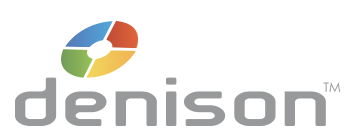Listening to the Voice of Your People:
Areas for Action in the Response to COVID-19
By Michael Schwendeman (Director, Research & Development) and Andrew Tenbrink (Research & Development Team)
Areas for Action in the Response to COVID-19
During the pandemic, organizations have been forced to transform the way they do business. From the physical space where work is done to the way that team members communicate, many things have changed. Some organizations have stepped up while others have failed to answer the call. At Denison Consulting, our research indicates that organizational culture strongly influences an organization’s response to the pandemic. Organizations with positive cultures are able to understand where they are headed, adapt to change, get their employees involved, and live out a consistent set of values. We think that there is much to be learned from how organizations with positive cultures have responded to COVID-19.
In an effort to explore their responses, we asked their employees “During the COVID-19 crisis, what are some of the things that your organization has done well?” By analyzing nearly 3000 comments across 20 organizations using natural language processing, we identified these five major themes that were most frequently discussed. These areas for action can serve as an example for how other organizations can effectively respond to the pandemic.
Communicating Effectively
Under normal circumstances, employees feel confident about their jobs and the direction of their organizations. For many this is no longer the case. Now employees are subject to an enormous amount of uncertainty surrounding the future of their employment. This creates immense stress for employees while also making it increasingly difficult for them to do their jobs. One strategy to mitigate these feelings is to facilitate transparent and effective communication.
Increased communication from leadership has been extremely well received by employees and was the most frequently discussed theme in employee comments. Leaders have made increased efforts to provide weekly updates that include information on the COVID-19 crisis and plans for the continuation of business. CEOs have made it a priority to communicate directly to their employees through mediums like recorded videos, live videoconferences, and written newsletters. Transparency has been a point of emphasis and employees appreciate having honest conversations regarding the future of their organization. Additionally, allowing employees to provide feedback has been an important step to ensure employees feel included.
Providing Sanitizer & Personal Protective Equipment
Employees are now facing risks at work that they never thought they would have to deal with. For those whose jobs have been deemed essential, going to work poses a serious health threat for themselves, their coworkers, and their families. These employees must rely heavily on leaders in their organizations to ensure that precautions are being taken to prevent the spread of COVID-19. Many of these changes can be uncomfortable for employees, but they are necessary to ensure that everyone is kept safe.

Organizations have made an enormous impact by providing personal protective equipment for their essential employees. This includes giving employees masks, gloves, and hand sanitizer to use while they are at work. There have also been major efforts undertaken to provide sanitation equipment and services to ensure that working environments are kept clean. In addition to taking caring of their own employees, some organizations have even been able to pivot their business to help combat COVID-19 by producing hand sanitizer and other personal protective equipment.
Transitioning to Work from Home
Some organizations have embraced policies surrounding telework while others remain wary of its effects on employee productivity and organizational culture. While being forced to quickly adopt telework policies, organizations and employees alike have learned a lot about their capabilities to get work done in new environments. Enabling work from home has allowed employees to continue to contribute to the organization while maintaining physical safety.
Quickly making the decision to allow employees to work from home was frequently mentioned in the survey comments. Not only did organizations simply begin to allow work from home, but they provided employees with the tools (e.g., laptops, monitors) and technical support needed to effectively adapt their work. This transition has also been supported by keeping employees informed regarding work expectations and changes to work policies. Allowing work from home has been greatly appreciated by employees and has empowered employees to better balance work with other aspects of their lives.
Prioritizing Health & Safety
Industries that operate predominately in typical office spaces do not face the same daily health and safety risks that other industries do. Now organizations across all industries are being called upon to protect the health, safety, and well-being of all of their employees, which for some presents a new and challenging expectation. Establishing that employees are taken care of can drastically reduce anxiety and help employees feel comfortable and engaged when continuing their work.
Organizations have worked to increase their focus on employee health and safety by quickly rolling out new policies and protocols for conducting business. Efforts to socially distance have been implemented by limiting in-office interactions and ensuring that necessary interactions are conducted in a safe manner. Specific actions have been taken like changing work schedules, reducing business hours, and restricting access to high-traffic work spaces. Mental health has also been prioritized by giving employees additional days off and sharing mental health resources. Taking these necessary steps has helped employees feel confident that the organization is operating with their best interest in mind
Maintaining Team Contact & Connection
With work transitioning from office spaces to virtual working environments, it can be increasingly difficult for team members to stay connected. Before the pandemic, it was easy to walk across the office to meet with your boss or ask for a team member’s opinion on a project. Now it takes more effort, intention, and coordination to keep these avenues of collaboration open. Encouraging and enabling teams to stay connected is an important step in maintaining effectiveness.

Employees appreciate that organizations have worked to ensure that teams can continue to function to the best of their abilities. Team leaders have taken action by encouraging the use of technologies like Microsoft Teams and Zoom to facilitate quality team interactions and coordination. Beyond technology, supervisors have set up specific times for team interaction by scheduling weekly team meetings while also working to preserve informal lines of communication. These actions have helped team members feel more empowered, engaged, and taken care of.
What Can Organizations Do Going Forward?
In summary, organizations have been asked to prioritize the needs of their employees. Our research indicates that many organizations have answered the call and their employees have taken notice. While this is certainly a victory, we acknowledge that the response to the pandemic is not over. Organizations must continue to take action and be proactive in their response. To do this, they should prioritize staying connected and keeping employees safe.
Staying Connected. Organizations can continue to support their employees by being intentional about connecting with them and keeping them informed. Specifically, leadership should provide frequent updates and access to new information regarding the response to COVID-19, managers should establish open lines of communication with their direct reports to monitor productivity, and employees should provide honest feedback to help improve internal processes. Organizations can achieve this by using a variety of communication channels such as emails, webinars, newsletter, and virtual meetings. Additionally, technology needs to continue to be leveraged to ensure that employees have the necessary resources to do their work. Taking these steps can help create a sense of stability when it is needed the most.
Keeping Employees Safe. Organizations can protect the health and safety of their workforce by continuing to provide resources. For remote workers, organizations should continue to support new work arrangements and invest in technology to better support telework. For essential workers, organizations should continue to provide PPE, sanitize work stations, and adapt existing work policies. When work transitions back to shared work spaces, organizations need to have a coordinated plan in place to make sure employees and customer feel safe. For example, Delta airlines has made extensive changes to their boarding process, flight schedules, and aircraft capacities in order mitigate safety risks. Further, organizations should empower employees by giving them the ability to speak up if they see something that might become a health risk. Continuing to make health and safety a priority will be essential for inspiring confidence in employees.
Overall, we hope that these insights can help organizations maintain effectiveness during these difficult times. Our goal is to continue conducting research that is focused on helping organizations navigate the challenges of the COVID-19 pandemic and build #RESILIENCE through organizational culture and leadership.
If you would like support in this process, please be in contact with us. We can help you achieve transformation right to the bottom line.
Subscribe to Denison insights
Keep up to date with new TRANSFORM articles or research, by subscribing here.







